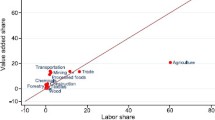Abstract
It is argued in this paper that agriculture plays a here-to-for unrecognized role in the process of structural change. In very poor countries agriculture is the key sector in the economy and agricultural prices greatly influence the overall price level in such an economy. It is hypothesized that if agricultural productivity grows faster than manufacturing productivity this will, under certain conditions, cause the price of the former to fall relative to the latter which in turn implies that the overall price level in the economy should fall, ceteris paribus. This results in a fall in the real effective exchange rate, ceteris paribus. This decline increases the competitiveness of producing tradable goods, in particular manufactured goods. Thus the process of structural change (shifting employment and resources out of agriculture) becomes easier. These hypotheses are empirically analyzed utilizing a data set for twelve Asian countries for an extended time period.
Similar content being viewed by others
References
Agbola FW, Damoense MY (2005) Time series estimation of import demand functions for pulses in India. J Econ Stud 32(2):146–157
Anderson K (2010) The political economy of agricultural Price distortions. Harvard University Press, Cambridge
Anderson K, Nelgen S (2013) Updated national and global estimates of distortions to agricultural incentives, 1995–2011. World Bank, Washington, D.C
APO (2018) APO Database. Asian Productivity Organization, Tokyo
Awokue T (2015) Does agriculture really matter for economic growth in developing countries. Can J Agric Econ 63(1):71–99
Balassa B (1964) The purchasing power parity doctrine: a reappraisal. J Polit Econ 72:584–596
Baldwin R., (2011), Trade and industrialization after Globalization’s 2nd unbundling: how building and joining a supply chain are different and why it matters,” NBER working paper no. 17716, Cambridge, pp. 1–39
Chang HL, Chen YS, SU CW, Chang YW (2008) The relationship between Stock Price and EPS: evidence based on Taiwan panel data. Econ Bull 3(30):1–12
Darvas Z., (2012), Real effective exchange rates for 178 countries: a new database, Working Paper 2012/06, Bruegel
De Vries G, Timmer M, De Vries K (2015) Structural transformation in Africa. J Dev Stud 51(6):674–688
Felipe J, Mehta A, and Rhee C, (2014), Manufacturing matters … but It’s the jobs that count, Asian Development Bank, Economic Working Paper Series, No. 420, pp. 1–35
Freeman DG (2003) Is health care a necessity or a luxury? Pooled estimates of income Elasticity from US state-level data. Appl Econ 35:495–502
Gollin D, Parente SL, Rogerson R (2007) The food production and the evolution of international income levels. J Monet Econ 54(4):1230–1255
Hassan F (2016) The Price of development: the Penn-Balassa-Samuelson effect revisited. J Int Econ 102:291–309
Im KS, Hashem Pesaran M, Shin Y (2003) Testing for unit roots in heterogeneous panels. J Econ 115(1):53–74
Johnston B, Mellor J (1961) The role of agriculture in economic development. Am Econ Rev 51(4):566–593
Levin A, Lin C-F, Chu C-SJ (2002) Unit root tests in panel data: Asyptotic and finite-sample properties. J Econ 108(1):1–24
Lewis WA (1954) Economic development with unlimited supplies of labour. Manch Sch 22:139–191
Liang C, Lin J, Hsu H (2013) Re-examining the relationships between Stock prices and exchange rates in ASEAN-5 using panel granger causality approach. Econ Model 32(3):560–563
Maddala CS, Wu S (1999) A comparative study of unit root tests with panel data and a simple new test. Oxf Bull Econ Stat 61:631–652
Ozturk I, Aslan A, Kalyoncu H (2010) Energy consumption and economic growth relationship: evidence from panel data for low and middle income countries. Energy Policy 38:4422–4428
Ranis G, Fei J (1961) A theory of economic development. Am Econ Rev 51(4):533–565
Ricci LA, Milesi-Ferretti GM, Lee J (2013) Real exchange rate fundamentals: a cross-country perspective. J Money, Credit, Bank 45(5):845–865
Rodrik D (2013) Unconditional convergence in manufacturing. Q J Econ 128(1):165–204
Rodrik D (2015) Premature Deindustrialization. J Econ Growth 21:1–33
Rodrik D, (2018), “New technologies, global value chains, and the developing economics: a background paper,” background paper no. 1, prosperity commission on technology and inclusive development, Oxford, pp. 1–27
Rogoff KS (1996) The purchasing-power parity puzzle. J Econ Lit 34:647–668
Samuelson P (1964) Theoretical notes on trade problems. Rev Econ Stat 46:145–154
Stock J, Watson M (1993) A simple estimator of Cointegrating vectors in higher order integrated systems. Econometrica 61(4):783–820
Timmer CP (2014) Managing structural transformation: a political economy approach. UNU-Wider, Helsinki
UNIDO, (2009), Structural change and sectoral growth in selected east Asian countries, Research and Statistics Branch, Working Paper 18/2009, pp. 1–66
Wade R (1990) Governing the market: economic theory and the role of the government in east Asian industrialization. Princeton University Press, Princeton
Author information
Authors and Affiliations
Corresponding author
Additional information
Publisher’s note
Springer Nature remains neutral with regard to jurisdictional claims in published maps and institutional affiliations.
Rights and permissions
About this article
Cite this article
Grabowski, R., Self, S. Structural change in Asia, the real effective exchange rate, and agricultural productivity. J Econ Finan 44, 198–210 (2020). https://doi.org/10.1007/s12197-019-09493-5
Published:
Issue Date:
DOI: https://doi.org/10.1007/s12197-019-09493-5




